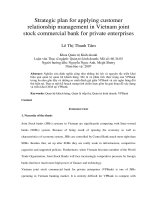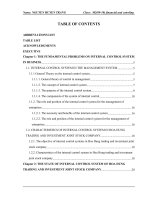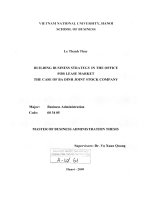EXPAND CAPITAL FUNDING BY ISSUING BONDS IN TASCO JOINT STOCK COMPANY
Bạn đang xem bản rút gọn của tài liệu. Xem và tải ngay bản đầy đủ của tài liệu tại đây (929.33 KB, 63 trang )
NATIONAL ECONOMICS UNIVERSITY
ADVANCED EDUCATIONAL PROGRAM
*****************************
BARCHELOR’S THESIS IN FINANCE
EXPAND CAPITAL FUNDING BY ISSUING
BONDS IN TASCO JOINT-STOCK COMPANY
2
ACKNOWLEDGEMENTS
From 11th March to 02nd June, I had an opportunity to have an internship in TASCO
Joint-stock Company. The new environment in a professional workplace was a great
chance for me to prepare for my near future; however, it was also a challenge for an
undergraduate student. Despite some difficulties I was really lucky to receive the helps
from many people and I really appreciate their kindness.
I wish to thank my parents for their tremendous support and advice which are really
helpful since I did not have any experience in a real work.
I would like to express my greatest gratitude to my supervisor Mr. Dang Ngoc Duc
because without his help and guidance this report cannot be completed. There are not
many supervisors who give advices and spend time talking with their students with
care just like his family members, and I sincerely appreciate his understandings and
empathy toward our problems.
I also want to give a special thank to my internship guide, Mr. Tran Huy Hoang,
Manager of Financial Department and all the department’s staffs in TASCO JSC. I
have been inspired by their enthusiasm and professional working style.
Supervisor: PhD. Đặng Ngọc Đức
Cao Thị Hồng Hạnh – Class AF51B
3
TABLE OF CONTENTS
ABBREVIATION
CDs
HNX
LIBOR
MOF
ROE
TASCO JSC.
Supervisor: PhD. Đặng Ngọc Đức
Certificate of deposits
Hanoi Exchange
London Interbank Offered Rate
Ministry of Finance
Return on equity
TASCO Joint-stock Company
Cao Thị Hồng Hạnh – Class AF51B
4
LIST OF TABLES
LIST OF FIGURES
CHAPTER 1: INTRODUCTION
1.1
Rationale
Vietnamese economy, in general, has been dominated by the banking system for a long
time. In the last few years, the difficulty in accessing capital markets through banking
channels has made many companies suffer the situation of lacking working capital. In
this situation, some companies have found their method to raising funds by issuing
bonds and gained some considerable achievements.
Corporate bond market has been born along with the introduction of stock market in
Vietnam firstly in July 2000. However, until the first half of 2012, the corporate bonds
Supervisor: PhD. Đặng Ngọc Đức
Cao Thị Hồng Hạnh – Class AF51B
5
accounted for only 8% of the total bonds value in Vietnam. Despite various weaknesses
in the Vietnamese bond market, corporate bonds have much potential to grow and
become a main method for raising company’s capital.
Understanding the advantages and disadvantages of issuing different types of bonds
will help people find the attractiveness of the corporate bonds and also the challenges
of issuing them.
In order to make a clearer illustration and give some suggestion to improve the
issuance of corporate bonds, particularly construction and real estate companies, the
topic “Improve the efficiency of raising capital through the issuance of bonds in
TASCO Joint-stock Company” was chosen to be analyzed in this report.
1.2
Objective
There are several objectives of the report, specifically
-
Give some overview about Joint stock companies and their method of raising
-
capital especially the method of issuing bonds.
Give more information and understandings about corporate bonds and their
advantages as well as disadvantages compared to other method of raising
-
capital.
Introduce TASCO JSC and their issuance of bonds.
Analyze and evaluate the bonds issuances at TASCO JSC.
Finally, from the analysis some suggestions will be proposed in order to improve the
company’s issuance of bonds in the future.
1.3
Methodology
Firstly, the data from the company official website and other information collected
while attending internship program is gathered and then selected to make a range of the
most suitable and valuable information relating to the research topic. The numbers and
figured collected then will be used to give illustrations when necessary.
Supervisor: PhD. Đặng Ngọc Đức
Cao Thị Hồng Hạnh – Class AF51B
6
In Chapter II, several opinions and secondary data that were selected from different
sources will be review to make a theoretical framework for the research. Finally, based
on the concept and theory in Chapter II, the case of TASCO JSC will be analyzed.
1.4
Scope
While introducing the Vietnamese bonds market, only the corporate bonds will be
focused. The government bonds will not be deeply mentioned since they are not the
main topic. Another limitation is that the suggestion will be made especially for the
case of Construction and Real Estate Company so there would be limitations when
applying for other companies in different industries.
In Chapter 2, the theoretical framework of the research will be reviewed. The basic
concepts of a company’s capital structure, especially which of Joint-stock company,
will be given. Then the definitions as well as the disadvantages and advantages of
several methods to raising capital in companies will be introduced. Particularly, the
concepts of raising capital through issuing bonds will be focused further in the third
part of the chapter.
In Chapter 3, there is an overview about Tasco JSC as well as its performance in the
industry. The bond issuances of Tasco from 2010 to present are also introduced in this
chapter.
Chapter 4 gives the detail analysis and evaluations to the issues of bonds in Tasco JSC.
They will be evaluate based on some given indicators; and from the analysis, some
proposals will be suggested to the company.
Supervisor: PhD. Đặng Ngọc Đức
Cao Thị Hồng Hạnh – Class AF51B
7
CHAPTER 2: OVERVIEW OF JOINT-STOCK COMPANY’S
CAPITAL MOBILIZATION AND BOND ISSUANCE
2.1
The concept of joint stock companies and joint-stock company's
capital structure
2.1.1
The concept of Joint-stock company
According to Article 77 in Vietnamese law on Enterprises 2005, a Joint-stock company
is defined as follow:
A joint-stock company is an enterprise where:
1) Its charter capital is divided into equal portions known as shares;
2) Shareholders may be organizations and/or individuals; the minimum number of
shareholders shall be three and shall not be restricted to any particular maximum
number;
3) Its shareholders shall be liable for debts and other property liabilities of such
enterprise within the limit of the value of their capital contribution to the
enterprise;
Supervisor: PhD. Đặng Ngọc Đức
Cao Thị Hồng Hạnh – Class AF51B
8
4) Shareholders shall be entitled to freely transfer their shares, except the case
specified in Clause 3 of Article 81 or Clause 5 of Article 84 of this Law.
Briefly, a joint-stock company is “An organization that falls between the definitions of
a partnership and corporation. This type of company issues stock and allows for
secondary market trading; however, stockholders are liable for company debts.” 1
Joint-stock companies have several characteristics:
The charter capital of a joint stock company is divided into equal portions called
shares. The equity owners are called shareholders. Each shareholder can buy one or
more shares.
A joint-stock company may issue multiple classes of shares, including common shares.
In addition, the Company may issue preference shares, including voting preference
shares, dividend preference shares, redeemable shares and others according to the
company’s charter.
The shares of a joint-stock company are easily transferable from one person to another
except the voting preference shares and the shares of founded shareholders. This
characteristic allows investors changing their investment objectives and methods in a
flexible manner.
The liability of the members of a company is restricted to the extent of the unpaid
value of the shares held by him. The personal asset of a shareholder cannot be used to
pay the company's liabilities (unlike the unlimited liability of the partners in a
partnership or business owners in private businesses).
The company may issue securities to the public for funding. This feature shows the
strong ability to raise capital from the public. Since huge amounts are collected as
capital, the operation of the business will generally be on a large scale basis.
The company has to have at least three shareholders and there is no limit for the
number of shareholder (Unlike the limited liability company with two members or
1 />
Supervisor: PhD. Đặng Ngọc Đức
Cao Thị Hồng Hạnh – Class AF51B
9
more, the number of member should not exceed 50). In the operating process,
shareholders are free to transfer their shares (except otherwise provided by law). Thus,
the number of shareholder of joint stock companies is usually very large.
2.1.2
Joint-stock company’s capital structure
The capital structure of a joint-stock company is a combination of its long-term debt,
specific short-term debt, common equity and preferred equity. In other words, the
capital structure is how a firm use different source of funds to finance its overall
operations and growth. Bonds, loans and commercial paper are examples of debt, while
equity is classified as common stock, preferred stock or retained earnings. Short-term
debt such as working capital requirements is also considered to be part of the capital
structure
2.2
Raising capital in Joint-stock companies
Companies have various ways to raise their capital; here are some methods that are
commonly used and their advantages as well as disadvantages for the companies using
them.
2.2.1
Issuing bonds
Corporate bonds are the means by which private firms borrow money directly from the
public; they typically pay semi-annual coupons and return the face value of the bond at
maturity.
When corporation issues bonds, they create one master loan agreement and offer
investors a chance to participate in the loan. The company offers the identical deal to
all investors regardless of whether the individuals interested in buying just one bond
each or corporations buying 1000 bonds. The master loan agreement between the
corporation and the investors is called a bond indenture. The indenture contains
information that you would expect in any loan agreement such as:
Supervisor: PhD. Đặng Ngọc Đức
Cao Thị Hồng Hạnh – Class AF51B
10
-
The amount of money the company is borrowing.
The interest rate the company will pay.
The collateral for the loan (if any).
When the company will make its interest payments.
Whether the company will pay off the loan, that is, when the bonds will mature.
Whether the company and/or the investors will have the choice of shortening the
bond's original maturity.
There are some characteristics that associated with bonds:
Face value/ Par value
The face value (also known as the par value or principal) is the amount of money a
holder will get back once a bond matures. A newly issued bond usually sells at the par
value. However, the par value is not the price of the bond. A bond's price fluctuates
throughout its life in response to a number of variables. When a bond trades at a price
above the face value, it is said to be selling at a premium. When a bond sells below
face value, it is said to be selling at a discount.
Coupon (The interest rate)
Coupon is the amount the bondholder will receive as interest payments. Sometimes
there are physical coupons on the bond that can be torn off and redeemed for interest.
However, records are more likely to be kept electronically.
Most bonds pay interest every six months, but it's possible for them to pay monthly,
quarterly or annually. The coupon is expressed as a percentage of the par value. For
instance, if a bond pays a coupon of 10% and its par value is $1,000, then it'll pay $100
of interest a year. A rate that stays as a fixed percentage of the par value like this is a
fixed-rate bond. Another possibility is an adjustable interest payment, known as a
Supervisor: PhD. Đặng Ngọc Đức
Cao Thị Hồng Hạnh – Class AF51B
11
floating-rate bond. In this case the interest rate is tied to market rates through an index,
such as the rate on Treasury bills.
Maturity
The maturity date is the date in the future on which the investor's principal will be
repaid. Maturities can range from one day to 30 years. In general, the longer the time to
maturity, the higher the interest rate. Also, all things being equal, a long term bond will
fluctuate more than a short term bond.
Credit rating
The bond rating system helps investors determine a company's credit risk. Blue-chip
firms, which are safer investments, have a high rating, while risky companies have a
low rating.
The chart below illustrates the different bond rating scales from the major rating
agencies: Moody's, Standard and Poor's and Fitch Ratings.2
Definition
Investment Grade
Prime, maximum safety
Very high grade/quality
Very high grade/quality
Very high grade/quality
Upper medium quality
Upper medium quality
Upper medium quality
Lower medium grade
Lower medium grade
Lower medium grade
Speculative
Speculative
Speculative
Highly speculative
Moody’s
S&P
Fitch
Aaa
Aa1
Aa2
Aa1
A1
A2
A3
Baa1
Baa2
Baa3
Ba1
Ba2
Ba3
B1
AAA
AA+
AA
AAA+
A
ABBB+
BBB
BBBBB+
BB
BBB+
AAA
AA+
AA
AAA+
A
ABBB+
BBB
BBBBB+
BB
BBB+
2 Source:
Supervisor: PhD. Đặng Ngọc Đức
Cao Thị Hồng Hạnh – Class AF51B
12
Highly speculative
B2
Highly speculative
B3
Substantial risk
Caa1
In poor standing
Caa2
In poor standing
Caa3
Extremely speculative
Ca
Maybe in or extremely close to default C
Default
Table 2. 1 Bond ratings
B
BCCC+
CCC
CCCCC
C+,C,CD
B
BCCC+
CCC
CCCCC
C+,C,CD
If the company falls below a certain credit rating, its grade changes from investment
quality to junk status. Because they are so risky, they have to offer much higher yields
than any other debt.
In the next section, the advantages and disadvantages of issuing bonds will be analyzed
in the comparison with the other means.
2.2.2
Selling common stocks
Common stocks, also known as equity securities, represent ownership shares in a
corporation. Each share of common stock entitles its owners to one vote on any matters
of corporate governance put to a vote at the company’s annual meeting and to a share
in the financial benefits of ownership such as the right to any dividends that the
corporation may choose to distribute. While the issuing of common stock can provide
substantial benefits, a few disadvantages arise from issuing common stock as well.
Advantages
First, the offering of common stock has the potential to raise large amounts of money.
A company can use these funds to invest in improvements, pay off debt or any number
of other things. In addition, unlike loans, the funding received from selling common
stock does not have to be repaid in any way.
Second, with common stock the company does not have an obligation to pay
dividends. As opposed with preferred stock that may stipulate a frequent dividend,
Supervisor: PhD. Đặng Ngọc Đức
Cao Thị Hồng Hạnh – Class AF51B
13
common stock does not mandate such a payment. The company is free to reinvest any
funds that would normally be used for dividends.
Disadvantages
Firstly, a primary disadvantage is the dilution of ownership. Since common stock is a
share of company ownership, once the stock is purchased the original owners have
other investors that they are responsible to. These common stockholders now have an
influence in the life of the corporation, and management will be held responsible for
increasing the value of the company's stock. For business owners that hold a tight grip
on operations, this fact can be a significant disadvantage.
Secondly, issuing stock significantly increases the cost of doing business, as companies
must list shares on an exchange, compile and file reports, submit to periodic
independent financial audits and provide a host of shareholder services, such as share
registration and stock ownership transfer.
2.2.3
Issuing preferred stocks
Preferred stocks are nonvoting shares in a corporation, usually paying a fixed stream of
dividends. In the other words, preferred stock has features similar to both equity and
debt. Like a bond, it promises to pay to its holder a fixed stream of income each year
and it does not give the holder voting power regarding the firm’s management.
Therefore, preferred stock is similar to an infinite-maturity bond. However, preferred
stock is an equity investment. The firm has no contractual obligation to pay the
dividend to the preferred stockholders. Instead, preferred dividends are usually
cumulative; that means the unpaid dividends cumulate and must be paid in full before
any dividend may be paid to holders of common stock. On the other hand, the firm
does have a contractual obligation to make timely interest payments on the debt.
Supervisor: PhD. Đặng Ngọc Đức
Cao Thị Hồng Hạnh – Class AF51B
14
Passing a preferred dividend cannot force the firm into bankruptcy but failure to make
the payments on the debt sets off corporate bankruptcy proceedings.
From the company perspective, there are both advantages and disadvantages of issuing
preferred stocks:
Advantages:
Firstly, it is the fixed rate of dividends. The rate of dividend is fixed throughout the
lifetime of the stock. Thus, regardless of the magnitude and volume of profits made by
the company, a preferred stockholder is always paid dividends at a fixed rate.
Therefore, the company knows in advance the exactly the amount of dividends they
have to pay, so they are able to plan and budget.
Secondly, preferred stockholders do not have the right to vote in the conduct of the
affairs of the company. The benefit is that the company can issue preferred shares
without diluting its ownership structure.
Thirdly, the prices of preferred stocks are quite stable that makes the investors more
willing to buy preferred stock since they are confident that they would be able to
recover at least the amount that they invested in the company. Moreover, they also get
dividends as and when the company declares them to recovering their initial
investment.
Disadvantage:
The main minus of issuing preferred stocks is that the company has to pay taxes on the
amount of dividends paid to the stockholders since the dividends are paid after taxes. In
addition, although preferred dividends can be passed, investors expect them to be paid
and firm intend to pay the dividends if conditions permit. Therefore, preferred
dividends are considered a fixed cost which increases the firm’s financial risk just like
that of debt.
Supervisor: PhD. Đặng Ngọc Đức
Cao Thị Hồng Hạnh – Class AF51B
15
2.2.4
Borrowing from banks
A bank loan is an extension of credit, to a consumer or business, in the form of
borrowed funds which has to be paid back with interest. A bank loan has many terms
and conditions and can be used for a number of different purposes. There are many
different types of loans and they have different qualifications. To get a loan, the
company must be qualified to the bank’s credit granting criteria. Each bank has their
rules, guideline and qualifying factors. Bank loans are available to finance the purchase
of inventory and equipment as well as to obtain operating capital and funds for
business expansion. These loans are a time-honored and reliable method of financing a
small business, but banks often only finance firms with substantial collateral and a long
track record, and the terms they offer are often very strict. Borrowing from a bank has
advantages and disadvantages, all of which the company owners should consider
carefully before making their move.
Advantages
Firstly, getting loans from banks is one of the simplest and most flexible ways to get the
needed funds. Bank loans offer a wide array of terms, fees, application requirements
and interest rates. These variables often differ from bank to bank, and usually can be
negotiated and adjusted. By offering a building or assets as collateral, the company can
often get low interest rates. Plus, the interest is often tax deductible as a business
expense. If the company is a sole proprietor, it typically gets the loan based on its
qualifications, such as income and credit history. For partnerships or corporations,
banks loans are generally based on business debt-to-income ratios and other financial
considerations.
Secondly, unlike other forms of loans and financing, the bank does not assume any sort
of ownership or influence in the way the business run. This is different from equity
financing, for example, through which investors take part ownership of the business.
Supervisor: PhD. Đặng Ngọc Đức
Cao Thị Hồng Hạnh – Class AF51B
16
Disadvantages
Bank loans bring a longer-term commitment than shareholder investment. The
company only has to pay back investors if the business earns money. Banks expect
their principal and interest payments every month, on time, whether the company
makes money or not. Failure to make timely payments can result in business credit
rating slipping, limiting the company’s borrowing power in the future. Having bank
loan commitments on the balance sheet increases the debt-to-asset and debt-to-equity
ratios, making the company less attractive to new creditors as well as potential
investors.
In addition, banks normally require a lengthy and thorough application process before
they will approve a business for a loan. Especially in the case of small businesses,
which often fail, banks want many details about the business plan before they are
confident about lending money. This can be a hassle and an obstacle to funding.
2.2.5
Using retained earnings
Retained earnings are the portion of net earnings not paid out as dividends, but retained
by the company to be reinvested in its core business or to pay debt. In most cases,
companies retain their earnings in order to invest them into areas where the company
can create growth opportunities, such as buying new machinery or spending the money
on more research and development. Advantages to retained profits are that there is
more capital available for growth and higher returns on investments and shareholder
equity. One of the disadvantages is that the company will not pay as many dividends.
Advantages
Firstly, one advantage to retained profits or earnings is that there is capital available
for growth. Improvements and expansion are expensive but necessary to remain
competitive. For example, designing new products and services requires research and
Supervisor: PhD. Đặng Ngọc Đức
Cao Thị Hồng Hạnh – Class AF51B
17
development, and these costs can be quite high. They are better funded from retained
profits.
Secondly, the company or business has self dependence and when it needs funds it has
its own available rather than having to ask anybody for loans. The business would
therefore save on interest as there is no interest to be paid off. The business is able to
keep certain information secret, which they may not want to let out to other companies.
This is not something that is possible when paying loans.
Thirdly, higher retained profits signal that the company is doing well and attracts
shareholders. When the demand for shares increases, the price and the overall value of
the company also increase.
Disadvantages
If the company's policy is to maximize retained profits, it can't disburse as many
dividends. Stocks that do not pay dividends will be less appealing to some investors.
High dividend stocks are usually inexpensive and are more accessible to the general
public. However, investors may decide that a cheaply priced stock is a sign that the
company is in trouble.
2.3
Raising capital through issuing bonds
2.3.1
The reasons why companies issue bonds
Corporations issue bonds for several reasons. Firstly, it is a way to raise capital without
diluting the current shareholders' equity. Secondly, with bonds, corporations can often
borrow at a lower interest rate than the rate available in banks. By issuing bonds
directly to the investor, companies can eliminate the banks which act the role of the
“middlemen” in the transactions. Therefore, the borrowing process becomes more
efficient and less expensive. Thirdly, by issuing bonds, corporations can often borrow
Supervisor: PhD. Đặng Ngọc Đức
Cao Thị Hồng Hạnh – Class AF51B
18
money for a fixed rate for a longer term than it could at a bank. Most banks will not
make fixed rate loans for longer than five years because they fear losing money if their
cost of funds (raised by selling CDs, savings accounts, etc.) rises to a higher rate than
long-term loans. Most companies want to borrow money for long terms and so elect to
issue bonds. Moreover, the bond market offers a very efficient way to borrow capital.
By issuing bonds, the borrower is spared the task of undergoing numerous separate
negotiations and transactions in order to raise the capital it needs.
2.3.2
The advantages and disadvantages of issuing bonds
The following are some advantages and disadvantages of issuing bonds.
Advantages
The first advantage is that debt issuance can also be advantageous from a governance
point of view. Creditors have no influence on the board or company policy—unlike
stockholders, who often have the right to vote on policies and the appointment of
directors. Thus, financing through debt can be very useful for companies that do not
want to change who is running the company or the general operations of the business.
Second, when company issues a bond, the bondholder knows exactly when he can cash
in the bond. The company also sets the rate of interest they will pay. Thus, the
repayment of the loans obtained via bonds is very predictable. This enables corporation
to estimate what the company's financial obligations will be at a specific point to some
degree, and the operating plan will be made easier.
Another advantage is that taking on debt by issuing bonds is usually cheaper than
either a bank overdraft or the cost of raising equity through a share issue. A major
advantage is that the return on debt (interest) is tax-deductible, while the return on
equity (dividends) is paid out of a company’s profits, which are taxed before dividend
payments can be made to stockholders. Overall, this means that bonds have a lower
after-tax cost.
Supervisor: PhD. Đặng Ngọc Đức
Cao Thị Hồng Hạnh – Class AF51B
19
Forth, when a company issues bonds, they are not obligated to share the profits
generated by using the loaned funds. The company only has to pay the face value of the
bond, plus the interest. If the company does well, this means they can get a very large
return for the money they have to pay out.
In addition, companies can improve their credit rating by issuing a small, manageable
number of bonds. If a firm is struggling with cash flow and performance issues, issuing
a few bonds can work wonders for lifting the company's credit rating on the bond
market. This will increase the attention and investment from the public.
Disadvantages
Fixed rate bonds are subject to interest rate risk, meaning that their market prices will
decrease in value when the generally prevailing interest rates rise. If interest rates rise,
and the bond is not a fixed-interest loan, the company is also in trouble, having to pay
both the principle and an ever-growing amount of interest. Variable rates mean that the
bond has to look out for the market and the fluctuations of interest rates. If there is no
fear of inflation or interest-rate spikes, all bond forms are advantageous. But if a
country is not economically stable, then issuing bonds might be a bad idea. Bonds are
also subject to various other risks such as call and prepayment risk, credit risk,
reinvestment risk, liquidity risk, event risk, exchange rate risk, volatility risk, inflation
risk, sovereign risk, and yield curve risk.
When companies issue bonds, they can't avoid increasing their overall debt and taking
on debt risk. The company must pay the interest even in years where they are
struggling, and when the bond matures, they have to pay the full face value. The
inability to meet this obligation can force the company into bankruptcy, which has its
own host of negative ramifications.
Although the public may perceive the acquisition of debt positively when the company
issue bonds since they generally like to see that a company has some cash or cash
Supervisor: PhD. Đặng Ngọc Đức
Cao Thị Hồng Hạnh – Class AF51B
20
equivalent on hand, they might see that action as a sign that the company is strapped
for cash, particularly when the company does not have a good bond rating. On top of
that they might walk away from the company’s stocks and products as well.
2.3.3
Types of bonds
There are many different types of bonds which can be divided based on different ways
of classification. The following are some bond-classification often used.
Coupon rates
Zero-coupon bonds do not pay any coupon. Instead of paying coupon they are issued at
a deep discount and pay the full value at the maturity.
Fixed-rate or straight bonds pay an absolute coupon rate over a specified period of
time. When it reaches maturity, the last coupon payment is made along with the par
value of the bond.
Floating rate bonds or floaters pay a coupon rate that varies according to the movement
of the underlying benchmark. However, they are set to be a fixed percentage above,
below, or equal to the benchmark. They typically follow some benchmark such as the
three, six or nine-month T-bill rate or LIBOR.
Inverse floaters pay a coupon rate that changes in the opposite direction of short-term
interest rates. An inverse floater subtracts the benchmark from a set coupon rate. For
instance, if an inverse floater uses LIBOR as the underlying benchmark it might pay a
coupon rate of a certain percentage minus LIBOR.
Features
Supervisor: PhD. Đặng Ngọc Đức
Cao Thị Hồng Hạnh – Class AF51B
21
Callable bonds give the bond issuer the right, but not the obligation, to redeem their
issue of bonds before the maturity of the bond. After calling its bonds, the company
could refinance its debt by reissuing bonds at a lower coupon rate. Callable bonds
typically come with a period of call protection, an initial time during which the bonds
are not callable. Such bonds are referred to as deferred callable bonds. The option to
call the bonds is valuable to the firm since it allows it to buy back the bonds and
refinance at a lower interest rates when market rates fall. To compensate for the
bondholders, callable bonds are issued with higher coupons and promised yields to
maturity than non-callable bonds.
Convertible bonds give bondholders an option to exchange each bond for a specified
number of shares of common stock of the firm at predetermined dates prior to the
bond’s maturity. Convertible bondholders benefit from price appreciation of the
company’s stock. Therefore, convertible bonds offer lower coupon rates and stated or
promised yields to maturity than non-convertible bonds.
Puttable bonds give bondholders the right but not the obligation to sell their bonds back
to the issuer at a specified price and date. These bonds generally protect investors from
interest rate risk. If the interest rates are higher than the bond's coupon rate, it is
optimal for investors to sell their bonds back to the issuer and reinvest their money at a
higher interest rate.
Collateral:
Mortgage bond is a bond secured by a pool of mortgage on one or more assets.
Typically, they are backed by real estate or physical equipment that can be liquidated.
If the issuer is in default, the mortgage bondholders have a claim to the underlying
property and could sell it off to compensate for the default. The average mortgage bond
often has a lower rate of return than non-collateral bonds since mortgage bonds are
mortgage-backed.
Supervisor: PhD. Đặng Ngọc Đức
Cao Thị Hồng Hạnh – Class AF51B
22
Collateral trust bond is a bond backed by other security such as stocks or other bonds
that is deposited and held by a trustee for the bondholders. They are backed by
collateral trust certificates and are usually issued by parent companies that are
borrowing against the securities of wholly owned subsidiaries. The securities are
delivered to the corporate trustee to hold for the benefit of the bondholders. However,
the issuer maintains voting rights that are granted by the securities. If the issuer
defaults, then the voting rights are transferred to the trustee and the trustee may also
sell the securities to pay the bondholders.
Debentures, which constitute most of the corporate bonds issued, are bonds that are not
secured by physical assets or collateral. Debentures are backed only by the general
credit worthiness and reputation of the company. However, the bondholders do have a
claim over all of the property of the issuer as a general creditor.
Guaranteed bonds are bonds whose payments and/or principal repayment are
guaranteed by a company which is not the issuer. Most guarantors are the parent
companies of the issuing subsidiary. In the event of a default, both companies are
responsible to make good on the bonds, so the credit quality of the bonds is generally
higher than non-guaranteed bonds.
Issuers
Another criterion used to classify corporate bonds is the type of the company that
issues them. Corporate bonds are mainly sold by firms in five areas. First is public
utilities which are usually issue bonds considered low risk. Second are conglomerates,
industrial and transportation companies. Next are financial services companies which
depend heavily on the bond market to raise capital and their bonds are more likely to
have high yield and high risk.
2.3.4
Offering methods: Public offering vs. Private placement
Supervisor: PhD. Đặng Ngọc Đức
Cao Thị Hồng Hạnh – Class AF51B
23
Definition
Advantages
Public offering
The sale of securities by an
organization to the public in
order to raise funds for business
expansion and investment
The company can approach a
large number of investors and
that also help their bonds have a
wider market.
The winning bidder(s) is the one
who has offered the lowest total
interest costs, so the company
can sell their bonds with lower
cost.
The bonds may be more
attractive because their market is
wide and they are more liquid
compared to private-offering
bonds.
Private placement
The sale of securities to a relatively
small number of select investors as
a way of raising capital.
The company does not need to
provide much disclosure to
investors because they usually
have a long-standing relationship
with the investors, or the investors
are a close-knit group that often
invests together.
A typical private placement will
not require an underwriter who
costs some fee for their services.
Private placement is useful if the
companies wish to keep their bond
offering confidential or if they
hope to raise money from only a
few people.
Disadvantage Public offering requires many of Private placement significantly
s
disclosure requirements such as narrows the range of investors the
a statutory prospectus for the company can reach.
investors or additional guidelines The company may need to expend
and details related to the bond more effort and expense to sell
issue.
bonds than in the typical public
The services of an underwriter offering because they cannot
are often used to conduct a advertise on a wide scale.
public offering and these Investors may also demand more
services charge some fees.
equity in the company to protect
their investments because the
company’s bonds do not have wide
market.
2.3.5 Evaluate the costs of raising capital
The cost of raising capital includes the interest expenses and non-interest expenses.
The interest costs account for the majority of the cost of raising capital. When raising
funds in the form of bonds, the company has increased its debt, and at the same time,
they have to pay interest payments to bondholders. The interest rate is dependent on the
Supervisor: PhD. Đặng Ngọc Đức
Cao Thị Hồng Hạnh – Class AF51B
24
term, strategic goals of the company, and bank’s interest rates during the release, etc.
Besides, the company also suffers other costs when raising capital: operating costs,
advertising costs, marketing to attract investors, insurance costs, management costs and
other costs related to capital raising activities.
The ratio between The costs of capital raising / Total capital raised was used to estimate
how many unit of cost to raise one unit of capital. Thus the funding need to consider
the cost of a capital in order to make sure that their income can offset this cost as well
as create some profit for the company. The lower the average costs of raising capital,
the more efficient the funding activity.
In addition, to calculate the cost of equity, two methods can be used, including Gordon
growth model and CAPM. In this report, Gordon model will be used to calculate the
cost of issuing new shares.
The equation for Dividend discount model:
re: cost of issuing new share
g: expected growth of dividend
g = (1-k)*ROE, k: payout ratio, ROE: return on equity
D1: dividend per share at the end of the first year
P0: actual amount received from a share (Price of one share – Average transaction cost)
CHAPTER 3: THE ISSUANCE OF BONDS AT TASCO JSC.
3.1
Vietnamese bond market and the situation of issuing bonds in
Vietnamese enterprises
The formation process of Vietnamese bond market
3/1991
The Ministry of Finance decided to issue treasury bills and treasury bonds
to raise capital for the state budget for investment and development. It was
the time that marked the introduction of the government bond market.
Supervisor: PhD. Đặng Ngọc Đức
Cao Thị Hồng Hạnh – Class AF51B
25
1991-1994
17/9/1994
1996
1995-1999
2000-2006
2007-2009
Bonds are issued directly by the State Treasury system in two forms:
short-term treasury bills (3-6 months) and medium-term treasury bonds
(1-3 years)
Funds raised from the Bills, bonds are primarily used to offset the state
budget deficit.
After the government issued the decree 120/CP of issuing shares and
bonds of state-owned enterprises, the corporate bond market started
forming.
The corporate bond market had a breakthrough initiated by the issuing of
$5 million worth of bonds by Corporation Refrigeration Electrical
Engineering (REE)
Government bond market had a significant development because of the
introduction of treasury bill auction through the SB’s exchange office with
the participation of commercial banks and financial institutions.
Government bond market entered a period of strong growth after the
issuance of Decree 01/2000/CP which changes the releasing mechanism of
government bonds.
New forms of bond issue began to operate, including bidding through the
STC, underwriting and selling bonds at discount prices.
During that period, the bond market has prospered. However, it was still
considered a very young market where the commodity was mainly
government bonds.
The total value of bonds issued was approximately 70,000-80,000 billion
VND, of which 80% are bonds issued by the Government.
9/2008, the Ministry of Finance decided to list and trade all the
government bonds on HNX. This decision (86/2008/QD-BTC) was an
attempt to increase the size and the depth of the market for government
bond segment.
6/2009, the bond trading system EBT was introduced, and this network is
the only electronic trading system on Vietnamese bond market.
Supervisor: PhD. Đặng Ngọc Đức
Cao Thị Hồng Hạnh – Class AF51B









